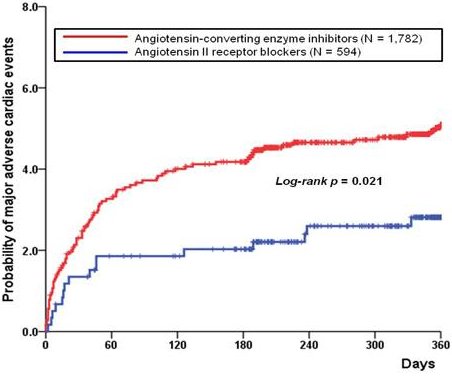| єя«•«ьљƒ : ±Єњђ
|
ЅҐЉцєш»£ - 550877 47 |
| Angiotensin receptor blockers as the first choice in patients with preserved left ventricular systolic function after acute myocardial infarction from the Korean Acute Myocardial Infarction Registry |
| к≤љлґБлМАнХЩкµР мЭШнХЩм†ДлђЄлМАнХЩмЫР мИЬнЩШкЄ∞лВік≥Љ¬є , мШБлВ®лМАнХЩкµР л≥СмЫР¬≤ , м†ДлВ®лМАнХЩкµРл≥СмЫР¬≥, лМАкµђк∞АнЖ®л¶≠лМАнХЩл≥СмЫРвБі , к≥Дл™ЕлМАнХЩкµРл≥СмЫР лПЩмВ∞мЭШл£МмЫР5 |
| кєАкЈ†нЭђ¬є , мµЬмЫРмДЭ¬є , л∞ХмД†нЭђ¬є , л∞∞л™ЕнЩШ¬є , мЭімЮ•нЫИ¬є , мЦСлПЩнЧМ¬є , л∞ХнЧМмЛЭ¬є , м°∞мЪ©кЈЉ¬є , м±ДмД±м≤†¬є , м†ДмЮђмЭА¬є , кєАмШБм°∞¬≤ , м†Хл™ЕнШЄ¬≥, кєАкЄ∞мЛЭ вБі , нЧИмКєнШЄ5 |
Background: It has not been known that the prognostic impact of angiotensin II receptor blockers (ARBs) compared with angiotensin-converting-enzyme inhibitors (ACEIs) in reducing major adverse cardiovascular events (MACE) in patients with preserved left ventricular systolic function after acute myocardial infarction (AMI). Methods: Between November 2005 and January 2008, 5,012 ACEI- or ARB-naïve patients (3,619 men; mean age = 61.6¬±12.4 year-old) with preserved left ventricular systolic function (left ventricular ejection fraction more than 40% by 2D echocardiogram) after AMI were included from the Korea AMI Registry. Patients who had already received ACEIs or ARBs before hospitalization were excluded from this study. The 12-month MACEs were defined as death and non-fatal MI. Results: The prescription rate of ARBs among these ACEI- or ARB-naïve patients was 14.4%. Before propensity score (PS) match, there were no significant differences in the 12-month MACEs (3.9% versus 3.6%, p = 0.664) and mortality (3.2% versus 3.0%, p = 0.810) between ACEIs use and ARBs use. For each patient, a PS indicating the likelihood of using ARBs during hospitalization or at discharge was calculated using a non-parsimonious multivariable logistic regression model, and was used to 1:3 match the patients on ARBs with the patients on ACEIs, leaving 594 ARBs users versus 1,782 ACEIs users. The 12-month MACEs and mortality were assessed using matched logistic and Cox regression models. Compared with ACEIs, the ARBs significantly reduced 12-month MACEs (2.7% versus 4.9%; hazard ratio [HR] 0.540, 95% confidence interval [CI] 0.317–0.920; p=0.023) and mortality (2.0% versus 3.8%; HR 0.525, 95%CI 0.284–0.969; p=0.039). Conclusion: In real-world practice, the 12-month MACEs and mortality were significantly higher in ACEIs users as compared with ARBs users in patients with preserved left ventricular systolic function after AMI. Much larger randomized controlled trials are required for these patients.
|
|
|
Warning: getimagesize(/home/virtual/circulationadmin/renewal/econgress/conference/abstract/img_files/fig_550877.jpg) [function.getimagesize]: failed to open stream: No such file or directory in /home/virtual/circulationadmin/new/econgress/conference/manage/schedule/view_abstract.php on line 164

|
|





